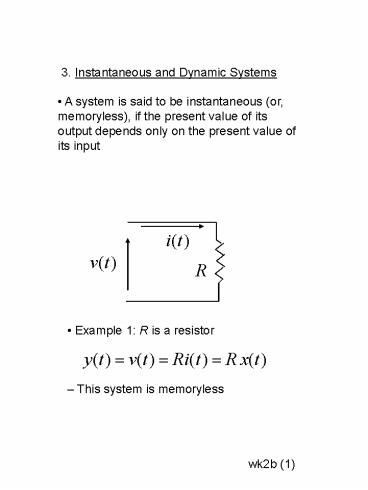3' Instantaneous and Dynamic Systems - PowerPoint PPT Presentation
1 / 8
Title:
3' Instantaneous and Dynamic Systems
Description:
... the present value of its output depends only on the present value of its input ... (1) Initial conditions at (2) Input for. i.e. ... – PowerPoint PPT presentation
Number of Views:30
Avg rating:3.0/5.0
Title: 3' Instantaneous and Dynamic Systems
1
- 3. Instantaneous and Dynamic Systems
- A system is said to be instantaneous (or,
memoryless), if the present value of its output
depends only on the present value of its input
- Example 1 R is a resistor
- This system is memoryless
2
- Example 2 C is a capacitor
- This system is with memory, because
- A linear time-variant memoryless system
- A linear time-invariant memoryless system
3
- 4. Other Classifications
- Causal and Non-causal Systems
- Lumped and distributed parameter systems
- Discrete-time systems
4
- Chapter 2
- Time-Domain Analysis of LTIC Systems
- LTIC means Linear, Time-Invariant,
Continuous-Time - 2-1 Response of a Linear System
- Consider SISO (single-input, single-output)
cases - A systems output for depends on two
causes - (1) Initial conditions at
- (2) Input for
- i.e. There are two parts in the output (a)
zero-input response (b) zero-state response
5
- Example 1 RC circuit (Fig. 1.26)
6
- Zero-Input (Z-I) response
- Result of internal system conditions
- Zero-State (Z-S) response
- Result of external input
- The Z-I and Z-S responses are independent each
other - Example 2 (RLC circuit, p. 80 and p. 111 of
textbook)
7
- Example
- The characteristic polynomial, equation, roots,
and modes
8
- Caveat !
- The output can also be expressed in another way
- Total output natural response forced response
- This concept is different than Z-I and Z-S
concepts - You should have known this in the Circuit
course(s) - Read Example 2.2 in p. 111 to refresh your
memory and enhance your understanding































